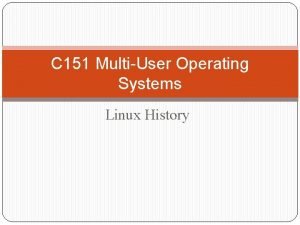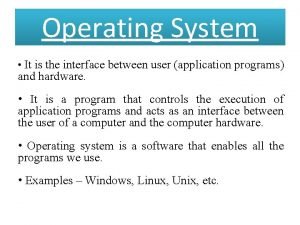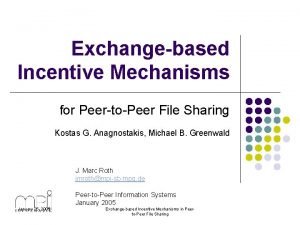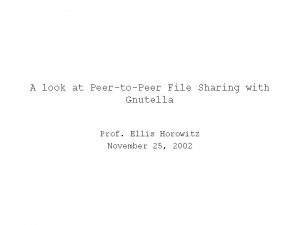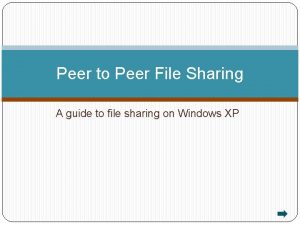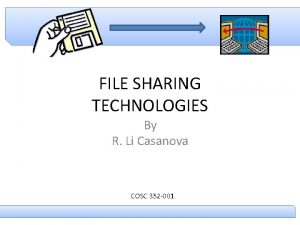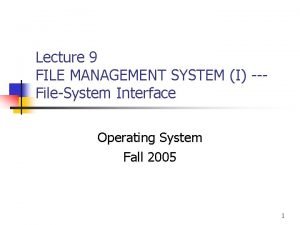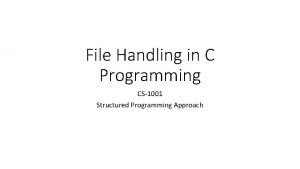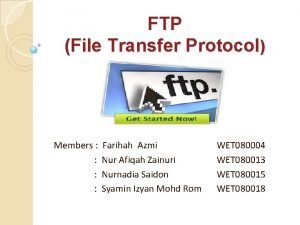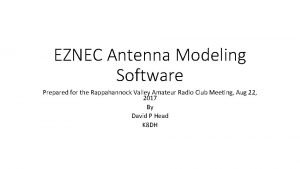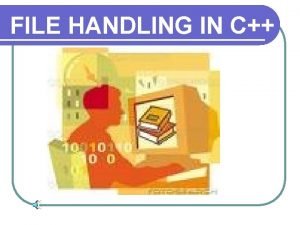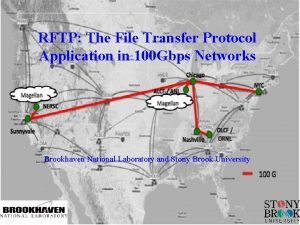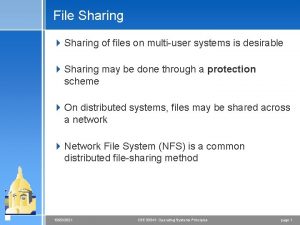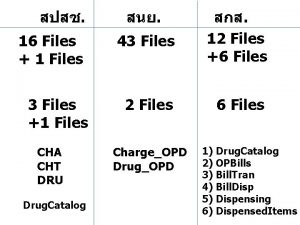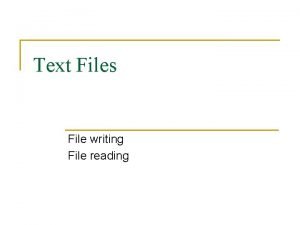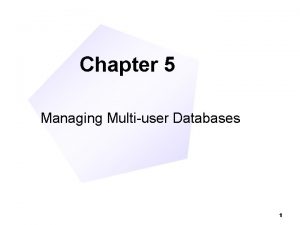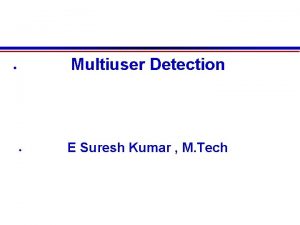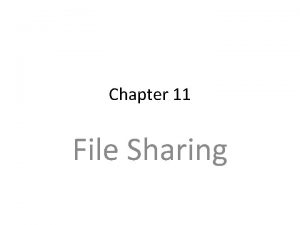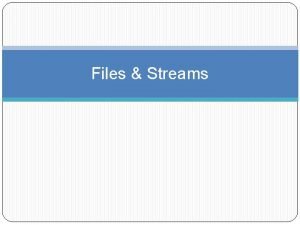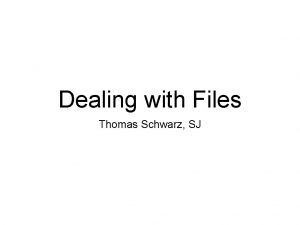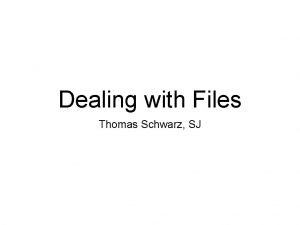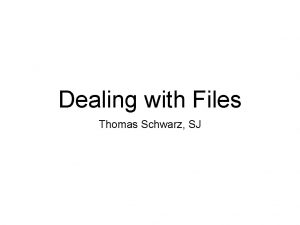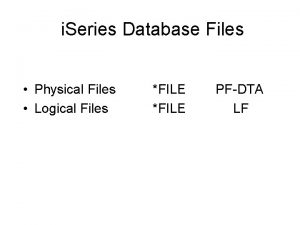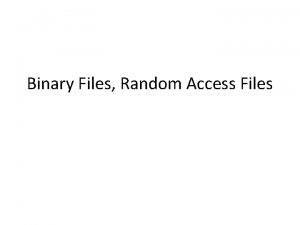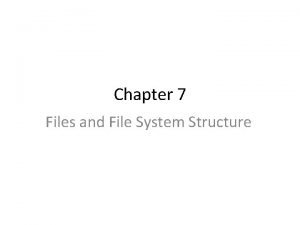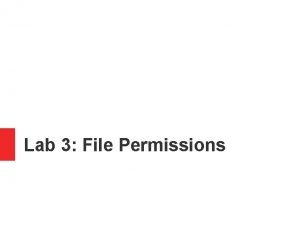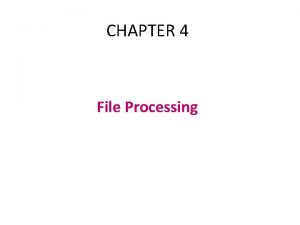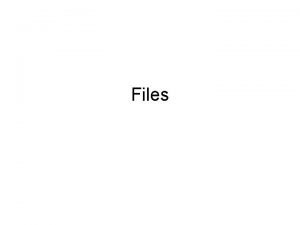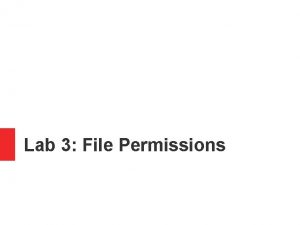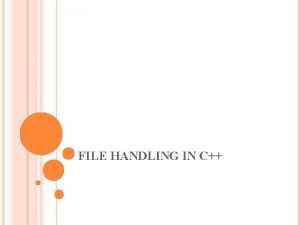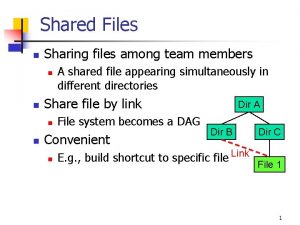File Sharing 4 Sharing of files on multiuser


























- Slides: 26

File Sharing 4 Sharing of files on multi-user systems is desirable 4 Sharing may be done through a protection scheme 4 On distributed systems, files may be shared across a network 4 Network File System (NFS) is a common distributed file-sharing method 10/28/2021 CSE 30341: Operating Systems Principles page 1

File Sharing – Multiple Users 4 User IDs identify users, allowing permissions and protections to be per-user 4 Group IDs allow users to be in groups, permitting group access rights 10/28/2021 CSE 30341: Operating Systems Principles page 2

File Sharing – Consistency Semantics 4 Consistency semantics specify how multiple users are to access a shared file simultaneously < Similar to Ch 7 process synchronization algorithms =Tend to be less complex due to disk I/O and network latency (for remote file systems < Andrew File System (AFS) implemented complex remote file sharing semantics < Unix file system (UFS) implements: =Writes to an open file visible immediately to other users of the same open file =Sharing file pointer to allow multiple users to read and write concurrently < AFS has session semantics =Writes only visible to sessions starting after the file is closed 10/28/2021 CSE 30341: Operating Systems Principles page 3

Protection 4 File owner/creator should be able to control: < what can be done < by whom 4 Types of access < Read < Write < Execute < Append < Delete < List 10/28/2021 CSE 30341: Operating Systems Principles page 4

Access Lists and Groups 4 Mode of access: read, write, execute 4 Three classes of users RWX a) owner access 7 111 RWX b) group access 6 110 RWX c) public access 1 001 4 Ask manager to create a group (unique name), say G, and add some users to the group. 4 For a particular file (say game) or subdirectory, define an appropriate access. owner group chmod 761 public game Attach a group to a file chgrp 10/28/2021 G game CSE 30341: Operating Systems Principles page 5

Windows XP Access-control List Management 10/28/2021 CSE 30341: Operating Systems Principles page 6

A Sample UNIX Directory Listing 10/28/2021 CSE 30341: Operating Systems Principles page 7

Chapter 11: File System Implementation 4 File structure < Logical storage unit < Collection of related information 4 File system resides on secondary storage (such as disks) 1. Boot control block - information needed to boot 2. Volume control block - information about volume/partitions (# blocks, size of blocks, free block count, free block pointers) 3. Directory structure (inode) 4. Per file control blocks 4 File system organized into layers 10/28/2021 CSE 30341: Operating Systems Principles page 8

Layered File System 10/28/2021 CSE 30341: Operating Systems Principles page 9

A Typical File Control Block 4 File control block – storage structure consisting of information about a file 10/28/2021 CSE 30341: Operating Systems Principles page 10

In-Memory File System Structures 10/28/2021 CSE 30341: Operating Systems Principles page 11

Virtual File Systems 4 There are many different file systems available on any operating systems < Windows: NTFS, FAT 32 < Linux: ext 2/ext 3, ufs, vfat, ramfs, tmpfs, reiserfs, xfs. . . 4 Virtual File Systems (VFS) provide an objectoriented way of implementing file systems 4 VFS allows the same system call interface (the API) to be used for different types of file systems 4 The API is to the VFS interface, rather than any specific type of file system 10/28/2021 CSE 30341: Operating Systems Principles page 12

Schematic View of Virtual File System 10/28/2021 CSE 30341: Operating Systems Principles page 13

Directory Implementation 4 Directories hold information about files 4 Linear list of file names with pointer to the data blocks. < simple to program < time-consuming to execute 4 Hash Table – linear list with hash data structure. < decreases directory search time < collisions – situations where two file names hash to the same location < fixed size 10/28/2021 CSE 30341: Operating Systems Principles page 14

Allocation Methods 4 An allocation method refers to how disk blocks are allocated for files: 4 Contiguous allocation 4 Linked allocation 4 Indexed allocation 10/28/2021 CSE 30341: Operating Systems Principles page 15

Contiguous Allocation 4 Each file occupies a set of contiguous blocks on the disk 4 Simple – only starting location (block #) and length (number of blocks) are required 4 Random access 4 Wasteful of space (dynamic storageallocation problem) 4 Files cannot grow 10/28/2021 CSE 30341: Operating Systems Principles page 16

Contiguous Allocation of Disk Space 10/28/2021 CSE 30341: Operating Systems Principles page 17

Extent-Based Systems 4 Many newer file systems (I. e. Veritas File System) use a modified contiguous allocation scheme 4 Extent-based file systems allocate disk blocks in extents 4 An extent is a contiguous block of disks < Extents are allocated for file allocation < A file consists of one or more extents. 10/28/2021 CSE 30341: Operating Systems Principles page 18

Linked Allocation 4 Each file is a linked list of disk blocks: blocks may be scattered anywhere on the disk. block = pointer 4 Simple – need only starting address 4 Free-space management system – no waste of space 4 No random access 10/28/2021 CSE 30341: Operating Systems Principles page 19

Linked Allocation 10/28/2021 CSE 30341: Operating Systems Principles page 20

File-Allocation Table (DOS FAT) 10/28/2021 CSE 30341: Operating Systems Principles page 21

Indexed Allocation 4 Brings all pointers together into the index block. 4 Logical view. index table 10/28/2021 CSE 30341: Operating Systems Principles page 22

Example of Indexed Allocation 10/28/2021 CSE 30341: Operating Systems Principles page 23

Indexed Allocation (Cont. ) 4 Need index table 4 Random access 4 Dynamic access without external fragmentation, but have overhead of index block. 4 Mapping from logical to physical in a file of maximum size of 256 K words and block size of 512 words. We need only 1 block for index table. 10/28/2021 CSE 30341: Operating Systems Principles page 24

Indexed Allocation – Mapping (Cont. ) � outer-index table 10/28/2021 CSE 30341: Operating Systems Principles file page 25

Combined Scheme: UNIX (4 K bytes per block) 10/28/2021 CSE 30341: Operating Systems Principles page 26
 Dot powai files are binary files
Dot powai files are binary files Cjis security levels
Cjis security levels Ncic hosts restricted files and non-restricted files
Ncic hosts restricted files and non-restricted files Uml diagram designer
Uml diagram designer Multiuser operating system
Multiuser operating system Interface between user and kernel
Interface between user and kernel File-file yang dibuat oleh user pada jenis file di linux
File-file yang dibuat oleh user pada jenis file di linux File sharing
File sharing Gnutella clients
Gnutella clients File sharing
File sharing Fungsi sistem file
Fungsi sistem file P file
P file File sharing technologies
File sharing technologies File sharing
File sharing File share best practices
File share best practices Physical image vs logical image
Physical image vs logical image Distributed file system definition
Distributed file system definition What does a markup tag tells the web browser
What does a markup tag tells the web browser In a file-oriented information system, a transaction file
In a file-oriented information system, a transaction file File pointer
File pointer Wet file transfer
Wet file transfer Www.bf.tku.edu.tw/files/news chapter 17
Www.bf.tku.edu.tw/files/news chapter 17 Eznec free download
Eznec free download Data files in c
Data files in c Attach2dynamics
Attach2dynamics Rftp
Rftp Crucial aspects of preparing digital audio files
Crucial aspects of preparing digital audio files




